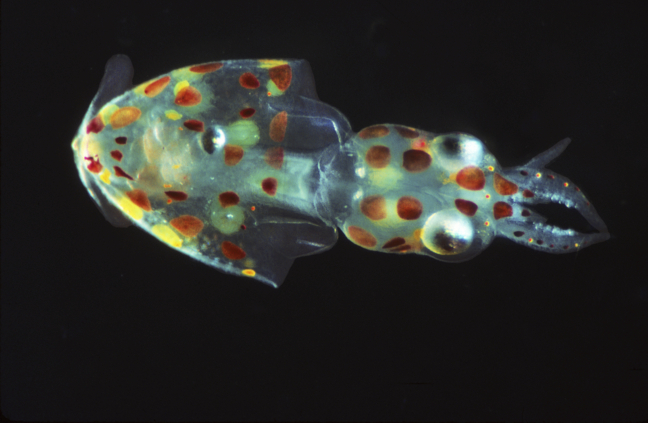Longfin squid are graceful swimmers that seem to glide through the water with little effort. As they swim at a low speed, their fins move in a wave-like fashion, but when they accelerate, their fins flap up and down. They are also capable of jet propulsion. Equipped with a tube-like siphon near the back of their head, they expel water from their body (mantle), sending them backward, away from a predator. Like other species of squid, they are equipped with ten arms, two of which serve to capture their next meal. When a prey comes into view, they dart toward it and snap up the prize with their two specialized arms. Equipped with pigment cells in their skin, they can quickly change their color to match their surroundings, helping them to avoid a predator.
Longfin squid feed on krill, small crabs and fish, shrimp, polychaete worms and smaller squid. Their predators include marine mammals, diving birds and large fish such as stripers, bluefish, sea bass, flounder, mackerel, spiny dogfish and others. Squid make great fish bait.
During the warmer months, longfin squid live over mud or mud/sand bottoms, near shore, at depths of 20 to 90+ feet. Throughout that time, they have been common in Long Island Sound and along our coastal Atlantic waters. During the day, they remain near the bottom, but at night they head toward the surface to feed on a variety of prey. The species inhabit the oceanic waters from Newfoundland to the Gulf of Venezuela. During the winter months, the more northern population migrate offshore, where they inhabit waters as deep as 1200 feet.

After mating, females deposit their fertilized eggs in clusters of finger-like capsules. Each capsule contains 100 to 200 eggs. A female typically produces from 3000 to 6000 eggs. The hatchlings grow fast, up to about a foot in body length. However, they have a very short life span, frequently less than one year! But despite their limited life span, longfin squid are a valuable resource in our coastal waters. According to NOAA, in 2022, the commercial landings of the squid reached 40.4 million pounds, valued at 60.2 million dollars! The majority are taken with small-mesh bottom trawls, though more recently, other vessels have used automatic squid jigging devices. Some squid are still harvested with pound nets and fish traps
Most of the commercial fishing for the longfin squid is operated out of ports in Rhode Island, New York, New Jersey and Massachusetts. Of those states, Rhode Island accounts for reportedly 50 percent of annual squid landings. The state’s Port of Galilee is the number one harbor for squid fishery on the east coast. Historically, most of the squid were exported to China, Spain and Italy. However, as Americans developed a taste for calamari’s slightly sweet, mild flavor, a large amount has been retained for our national markets.
For recreational fishing, there are no limits on the possession of longfin squid. Like other species of squid, longfins are most active at night. They can be caught from an illuminated jetty or pier, especially in areas with nearby large clusters of dense seagrasses, where they hide from their predators. They are also found over sand bottoms. When fishing from a boat, hang lights over both sides; lights attract them. In Rhode Island, the 1000-foot-long lighted Goat Island Causeway is a favorite for squid fishermen.
Squid can be captured with a long-handle dip net, but squid jigs are usually much more productive. Using rod and reel, choose a long, light rod equipped with a light line. Some anglers prefer a 6 to 10-lb mono line while others feel that a braid line creates better action with the lure. At the end of the line, tie the jig with a light fluorocarbon leader. Cast out the lure and let it sink toward the bottom. Then gradually reel it in twitching the rod two to three times, before letting it sink slowly back down again. The whole idea is to keep the jig constantly moving. If you are not getting any hits, change to another size or color jig. To better attract a hungry squid, some anglers attach a small strip of bait on the jig, using rubber bands. When you feel a solid pull on your line, jerk your pole slightly to ensure that the squid is hooked and reel it in. However, be sure to allow your catch to first expel its dark ink before bringing it ashore or aboard your boat; if the ink gets on your clothes, wash it out before it dries.
Longfin squid are delicious for any seafood lover. They are a fantastic source of lean protein and a host of other nutrients such as Vitamin B12, zinc and riboflavin. Used as bait, they are great for catching bluefish, fluke, striped bass, weakfish, small sharks and a long list of other marine species. Best of luck while fishing for this valuable resource in our coastal waters.
